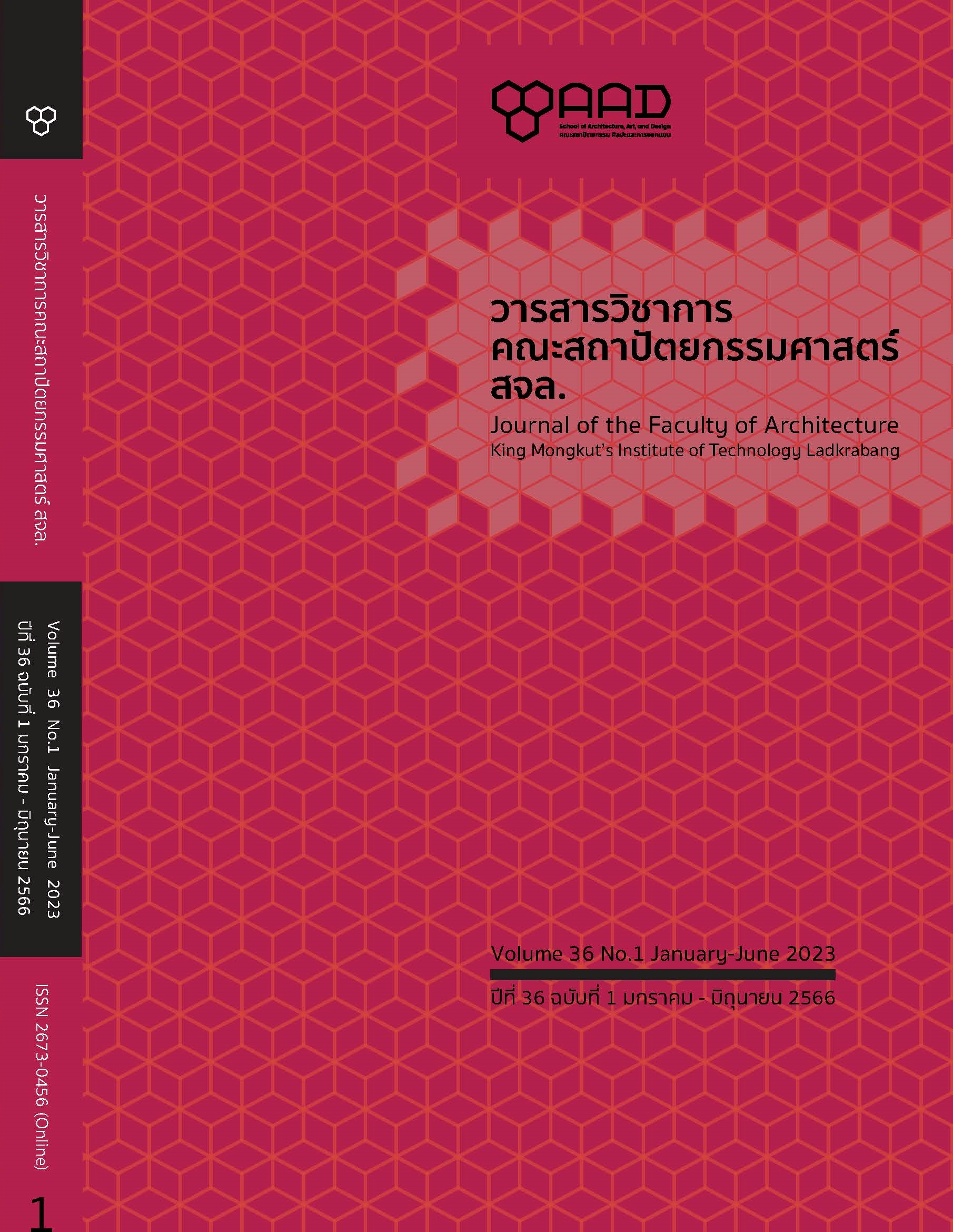Analysis of Sustainable Green Areas in Rajamangala University of Technology Isan
Main Article Content
Abstract
The objective of this research project is to analysis sustainable green areas in Rajamangala University of Technology Isan (RMUTI) locates in Nakhonratchasima City Municipality (NCM) of Nakhon Ratchasima province under the action policy of green area management in sustainable city of Office of Natural Resources and Environmental Policy and Planning (ONEP). This links with policy of RMUTI-green university in the preservation of green areas and native vegetation. Methods included 1) reviewing related literature such as the study of sustainable urban green spaces. and application of geospatial technology, 2) collecting and surveying data such as data of green areas in RMUTI from aerial photographs in the Google Earth program to be used to survey tree species with web ArcGIS Survey123, 3) preparing Geographic Information System (GIS) data obtained from (2) as GIS data layer using ArcGIS program, 4) analyzing spatial data in ArcGIS program with overlapping technique between results obtained in (3) to analyze sustainable green areas and 5) reporting and summarizing data, including maps, tables, and narratives for spatial presentations.
The results were found that green spaces 217.74 rai (65.98%) and non-green spaces 112.26 rai (34.02%) of study area (330.00 rai). Exploration of the mentioned defined tree species in each type of green spaces was found that is sustainable green spaces 170.98 rai (51.82%) with 1,239 of 1,363 trees (90.90%) and 57 of 58 tree species (98.28%). Sustainable green spaces can be mostly seen in type of narrow stripes along traffic ways (100.00%) and type of recreation and landscape outlook (91.88%). Moreover, ratio of RMUTI-green spaces is analyzed, this is still in accordance of ONEP action plan. Consequently, RMUTI will take to develop and improve in take caring and maintain these sustainable green areas further because it is one important mission of green university policy for infrastructure of RMUTI.
Article Details

This work is licensed under a Creative Commons Attribution-NonCommercial-NoDerivatives 4.0 International License.
This work is licensed under a Creative Commons Attribution-NonCommercial-ShareAlike 4.0 International License.
Copyright Transfer Statement
The copyright of this article is transferred to Journal of The Faculty of Architecture King Mongkut's Institute of Technology Ladkrabang with effect if and when the article is accepted for publication. The copyright transfer covers the exclusive right to reproduce and distribute the article, including reprints, translations, photographic reproductions, electronic form (offline, online) or any other reproductions of similar nature.
The author warrants that this contribution is original and that he/she has full power to make this grant. The author signs for and accepts responsibility for releasing this material on behalf of any and all co-authors.
References
กรมชลประทาน. (2559). แอปพลิเคชั่นพร้อมใช้งาน Survey123 for ArcGIS. เข้าถึงได้จาก: http://water.rid.go.th/hydhome/ma/pictures/2559%20%202559/2559%202559%202559/5531.pdf
การไฟฟ้าส่วนภูมิภาค. (2564). คู่มือการใช้งาน Application Survey123 for ArcGIS. เข้าถึงได้จาก: https://gisportal.pea.co.th/portal/home
ชรัยย์รัชฎ์ บวรวัฒนะ และณัชวิชญ์ ติกุล. (2558). แนวทางการประเมินการจัดการพื้นที่สีเขียวที่เป็นมิตรต่อสิ่งแวดล้อมในสถาบันอุดมศึกษา. เข้าถึงได้จาก https://erp.mju.ac.th/openFile.aspx?id=MTg2NDY5&method=inline
ทิฆัมพร หัดขุนทด เยาวเรศ จันทะคัต และปฐมาวดี คุ้นกระโทก. (2563). การศึกษาพื้นที่สีเขียวด้วยหลักการการจัดการพื้นที่สีเขียวชุมชนเมืองอย่างยั่งยืน กรณีศึกษามหาวิทยาลัยเทคโนโลยีราชมงคลอีสาน นครราชสีมา (ศูนย์กลาง). วารสารวิชาการเพื่อพัฒนานวัตกรรมเชิงพื้นที่. 1(3), 1-12.
ปุณยนุช รุธิรโก และชนิษฎา ชูสุข. (2562). การประยุกต์ระบบสารสนเทศภูมิศาสตร์ในการหาพื้นที่เหมาะสมเพื่อพัฒนาเป็นพื้นที่สีเขียวเพื่อนันนทนาการในเขตเทศบาลนครหาดใหญ่และเทศบาลคอหงส์ อำเภอหาดใหญ่ จังหวัดสงขลา. วารสารวิทยาศาสตร์และเทคโนโลยี มหาวิทยาลัยอุบลราชธานี, 21(2), 10-21.
พงศ์ปกรณ์ ผิวผ่อง, สุรินทร์ อ้นพรม และ ศศิยา ศิริพานิช. (2561). แนวทางการจัดการพื้นที่สีเขียวในมหาวิทยาลัยเกษตรศาสตร์ วิทยาเขตกำแพงแสน. วารสารการจัดการป่าไม้, 12(23), 77-87.
พรพิชชา นันตา. (2563). แนวทางการเพิ่มพื้นที่สีเขียว และการประเมินศักยภาพพื้นที่สีเขียวในเขตวัฒนา กรุงเทพมหานคร. สาระศาสตร์, 3(4), 908-920.
มหาวิทยาลัยเกษตรศาสตร์. (2547). รายงานฉบับสมบูรณ์ มาตรการในการเพิ่มและการจัดการพื้นที่สีเขียวในเขตชุมชนอย่างยั่งยืน. กรุงเทพฯ: สำนักงานนโยบายและแผนทรัพยากรธรรมชาติและสิ่งแวดล้อม กระทรวงทรัพยากรธรรมชาติและสิ่งแวดล้อม.
มหาวิทยาลัยเทคโนโลยีราชมงคลอีสาน. (2561). ประกาศมหาวิทยาลัยเทคโนโลยีราชมงคลอีสาน เรื่อง นโยบายมหาวิทยาลัยสีเขียว. เข้าถึงได้จาก: https://www.fte.rmuti.ac.th/main/sites/default/files/ประกาศ%20-%20นโยบายมหาวิทยาลัยสีเขียว.pdf
มหาวิทยาลัยเทคโนโลยีสุรนารี. (2557). การจัดทำมาตรฐานพื้นที่สีเขียวในเมืองและชนิดพรรณไม้ที่เหมาะสมกับพื้นที่สีเขียวภายใต้โครงการพัฒนาเมืองและชุมชนเพื่อมุ่งสู่สังคมคาร์บอนต่ำ ปีงบประมาณ 2557. กรุงเทพฯ: สำนักงานนโยบายและแผนทรัพยากรธรรมชาติและสิ่งแวดล้อม กระทรวงทรัพยากรธรรมชาติและสิ่งแวดล้อม.
เยาวเรศ จันทะคัต, เสกสรร มังคลานันท์, พรทิพย์ เอื้อธรรมถาวร, วรพล อารีย์, จอมภัค จันทะคัต และพงศ์พันธุ์ จันทะคัต. (2564a). รายงานฉบับสมบูรณ์ แนวทางการพัฒนามหาวิทยาลัยสีเขียวอย่างยั่งยืน กรณีศึกษามหาวิทยาลัยเทคโนโลยีราชมงคลอีสาน นครราชสีมา. นครราชสีมา: มหาวิทยาลัยเทคโนโลยีราชมงคลอีสาน.
เยาวเรศ จันทะคัต และ พงศ์พันธุ์ จันทะคัต. (2563). การเปรียบเทียบเชิงพื้นที่และเวลาเพื่อศึกษาการเปลี่ยนแปลงและความหลากหลายการใช้ที่ดินในเทศบาลนครนครราชสีมา อำเภอเมือง และจังหวัดนครราชสีมา. วารสารวิทยาศาสตร์และเทคโนโลยี. 29(4), 728-740.
วราลักษณ์ คงอ้วน และ พุฒพรรณี ศีตะจิตต์. (2556). การจัดการพื้นที่สีเขียวในสถาบันการศึกษาตาม แผนปฏิบัติการเชิงนโยบายด้านการจัดการพื้นที่สีเขียวชุมชนเมืองอยางยั่งยืน. เข้าถึงได้จาก: http://www.arch.chula.ac.th/journal/files/article/a4pjcHtHRwThu90740.pdf
วราลักษณ์ คงอ้วน (2554). การจัดการพื้นที่สีเขียวในสถาบันศึกษา: กรณีศึกษามหาวิทยาลัยธรรมศาสตร์ ศูนย์รังสิต. วารสารวิชาการคณะสถาปัตยกรรมศาสตร์ สจล., 13(2), 74-87.
ศูนย์วิจัยภูมิสารสนเทศเพื่อประเทศไทย. (2542). ความหมายของคำว่า ระบบสารสนเทศภูมิศาสตร์ (Geographic Information System) GIS. เข้าถึงได้จาก: http://www.gisthai.org/about-gis/gis.html
สถาบันสารสนเทศทรัพยากรน้ำ (องค์การมหาชน). (2562). ระบบภูมิสารสนเทศผ่านเครือข่ายอินเทอร์เน็ต. เข้าถึงได้จาก: https://www.hii.or.th/งานของเรา/งานวิจัยและพัฒนา/ 2019/10/02/ระบบภูมิสารสนเทศผ่านแค
สำนักงานนโยบายและแผนทรัพยากรธรรมชาติและสิ่งแวดล้อม. (2564). พื้นที่สีเขียว. เข้าถึงได้จาก: https://www.onep.go.th/พื้นที่สีเขียว
สำนักงานนโยบายและแผนทรัพยากรธรรมชาติและสิ่งแวดล้อม. (2562). แนวทางการขับเคลื่อนการจัดการพื้นที่สีเขียวอย่างยั่งยืน. เข้าถึงได้จาก: https://www.dol.go.th/plan/DocLib2/eurban-publi.pdf
สำนักงานนโยบายและแผนทรัพยากรธรรมชาติและสิ่งแวดล้อม. (2550). แผนปฏิบัติการเชิงนโยบายด้านการจัดการพื้นที่สีเขียวชุมชนเมืองอย่างยั่งยืน. เข้าถึงได้จาก: https://www.onep.go.th/book/แผนปฏิบัติการเชิงนโยบา/.
Bartlett, P.F. and Chase, G.W. (2013). Sustainability in Higher Education: Stories and Strategies for Transformation. Massachusetts: The MIT Press.
Bogerd, N., Dijkstra, S.C., Seidell, J.C. and Maas, J. (2018). Greenery in the university environment: Students’ preferences and perceived restoration likelihood. PLoS One 13(2): 1-19.
Campbell, J.B. (1987). Introduction to Remote Sensing. New York: The Guilford Press.
DAYEH University Sustainability. (2021). Current Situation on the Promotion of “Green University”—Da-yeh University: The Greenest University in Taiwan. Retrieved from http://green.dyu.edu.tw/en_2120.php
ESRI. (2019). Overlay analysis. Retrieved from: https://desktop.arcgis.com/en/arcmap/10.6/analyze/commonly-used-tools/overlay-analysis.htm
ESRI. (2016). Survey123 for ArcGIS. Retrieved from: https://webportal.bangkok.go.th/upload/user/00000138/train2563/Survey123%20For%20ArcGis.pdf
ESRI. (2021). ArcGIS survey 123. Retrieved from: https://www.esri.com/en-us/arcgis/products/arcgis- survey123/overview#:~:text=ArcGIS%20Survey123%20is%20a%20complete,when%20disconnected%20from%20the%20Internet
Fitzpatrick-Lins, K. (1981). Comparison of Sampling Procedures and Data Analysis for a Land-use and Land-cover Map. Photogrammetric Engineering & Remote Sensing. 55(4), 475-478.
Haas, W. D., Hassink, J. and Stuiver, M. (2021). The Role of Urban Green Space in Promoting Inclusion: Experiences
From the Netherlands. Retrieved from: https://www.wur.nl/en/Publication-details.htm?publicationId=publication-way-353836303930
Jantakat, Y. and Juntakut, P. (2020). Assessing Green City-based Tree Cover Change in Nakhonratchasima City Municipality. International Journal of Building, Urban, Interior and Landscape Technology (BUILT), 16, 33-46.
Jensen, J. R. (2007). Remote Sensing of the Environment: An Earth Resource Perspective. Massachusetts: Pearson Education, Inc.
Lang, R. E. and Dhavale, D. (2005). Beyond Megalopolis: Exploring America ond Megalopolis: Exploring America’s New “Megapolitans New “Megapolitan” Geography. Retrieved from: https://digitalscholarship.unlv.edu/cgi/viewcontent.cgi?article=1038&context=brookings_pubs
McFarland, A. L., Waliczek, T. M., and Zajicek, J. M.. (2008). The relationship between student use of campus green spaces and perceptions of quality of life. Horttechnology, 18 (2), 232-238.
Rajamangala University of Technology Isan. (2021). History of University. Retrieved from: https://rmuti.ac.th/main/about/history
The University of Sheffield. (2021). Sustainability at Sheffield. Retrieved from: https://www.sheffield.ac.uk/sustainability/green-spaces
UNESCO. (2021). Sustainable Development. Retrieved from: https://en.unesco.org/themes/education-sustainable-development/what-is-esd/sd. University of Indonesia. (2023). What is UI GreenMetric?. Retrieved from: https://greenmetric.ui.ac.id/about/welcome


